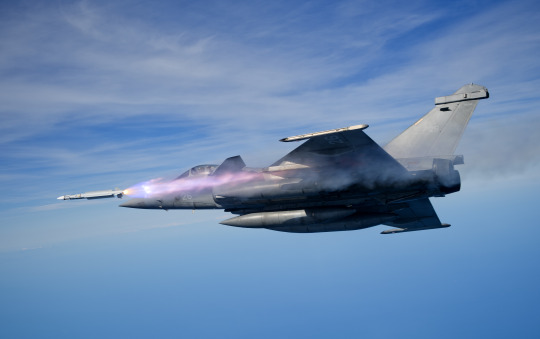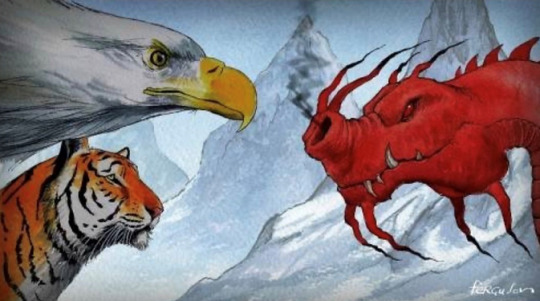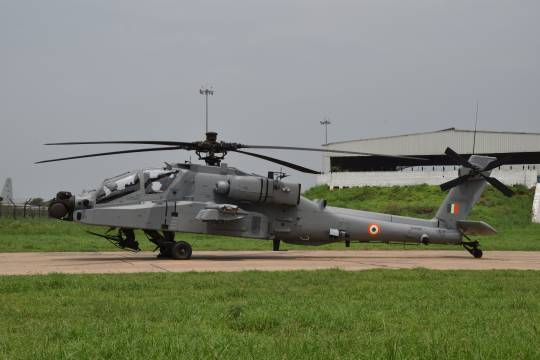#Atmanirbar Bharat
Text
Interview: MBDA-L&T joint venture aims to be lead private missile-maker in India
Interview: MBDA-L&T joint venture aims to be lead private missile-maker in India
L&T MBDA Missile Systems Limited director Arun Ramchandani tells our editor N. C. Bipindra in an interview during DefExpo-2022 that ‘Sea Ceptor‘ offering to the Indian Navy for its air defence requirement is a futuristic technology. The company is currently making MICA missile equipment in Coimbatore in Tamil Nadu for the Indian Air Force‘s Mirage-2000 requirement, apart from exporting them.
Q.…

View On WordPress
#Aatmanirbar Bharat#Aatmanirbhar Bharat#Air Defence#Air Defence Missile#Air Defence System#Air Force#Anti-Tank Guided Missile#Army#Arun Ramchandani#ATGM#Atmanirbar Bharat#Atmanirbhar Bharat#Beyond Visual Range#BVR#Coimbatore#Combat Aircraft#Combat Jet#Fighter Aircraft#fighter jet#IAF#India#Indian#Indian Air Force#Indian Army#Indian Navy#L&T#L&T MBDA Missile Systems Limited#Larsen & Toubro#Larsen and Toubro#Make in India
9 notes
·
View notes
Text
Tame the Dragon
It was on 9 November 1989, five days after half a million people gathered in East Berlin in a mass protest the Berlin Wall dividing communist East Germany from West Germany crumbled. It culminated in one of the most famous scenes in recent history - the fall of the Berlin Wall. An end to the Cold War was declared at the Malta Summit three weeks later, and the reunification of Germany took place in October the following year. It took US (and west) around 45 years after world war-2 to claim the triumph over mighty Soviet Union when it got dissolved in Dec 1991. The similarities between communist USSR and present day China in their hegemonic, expansionist, tyrannical, authoritarian, Orwellian regimes are not unfathomable.

Rise of China, its Military and Economical Potency
Rise of china started in 1980, due to initiation of economic reforms and trade liberalization with real annual gross domestic product (GDP) growth averaging 9.5% through 2018, a pace described by the World Bank as “the fastest sustained expansion by a major economy in history.” Such growth has enabled China, on average, to double its GDP every eight years and helped raise an estimated 800 million people out of poverty and becoming second highest GDP around 13.41 trillion USD in 2018.
In terms of Military strength, Second only to the U.S. and Russia, the Chinese military continues to grow alongside a local burgeoning Military-Industrial Complex with around 21 lakhs active personnel and around 175 billion USD budget.
Threat of China to India and stability of world at large
Chinese leadership interpreted 2008 financial crisis as decline of US supremacy & inadequacy to maintain stability in economy. First manifestation of China asserting its belligerent policies started in March 2010 with its expansive claim over South China Sea. Chinese claim over South China Sea was projected as their core interest and non-negotiable like Tibet and Taiwan. In November 2012 at 18th Party Congress of CCP ,Hu Jintao who was loathe to be seen as weak in foreign policy, especially in the context of a rapidly growing concern about social stability and regime legitimacy was succeed by Xi Jinping. After that number of steps undertook by PRC to increase their stakes in world stability. In series of that, Launching of Belt and road initiative in 2013 widely seen as agenda to threaten sovereignty, export sub-standard norms and practices, ensnaring developing countries with debt dependence and then translating that dependence into geopolitical influence. China’s actions in Sri Lanka, Pakistan, and Malaysia are central to the “debt trap diplomacy” debates. This was followed by numerous controversies over dubious cyber activities, maritime and land disputes with its neighbor (such as India, Vietnam, Japan, Taiwan, and Philippines), ethnic atrocities on Uighur Muslims in Xinxiang, curbing anti-china protest in Hong Kong and Trade war with US.
By any parameters, one can safely conclude that china has been overtly challenging US and west domination on world affairs in all facets over a decade now and pose severe threat to regional & world stability.
On domestic front, New Delhi has been very skeptical and apprehensive about Beijing and its hawkish polices after trauma of 1962 war. The event of Doklam, raising Kashmir issue in UN, blocking India’s entry into NSG (Nuclear Supplier Group), Supporting jihadi terrorist on international forums, pact with Pakistan for CPEC with an aim to undermine India’s sovereignty and now killing of 20 Indian soldiers in Ladakh by PLA has unsurprisingly conveyed the devious plot of evil Xi-Jinping regime to destabilize India. China is also following the strategy of containing India in maritime region by establishing bases for the forward deployment of their naval assets and to gain relative advantage and leverage Indo-pacific region.
Now, outbreak of Covid-19 pandemic allegedly originated in wet markets of Chinese city of Wuhan and its information suppressed by China has really triggered the conflict between world and China wide open. The world is now badly suffering with devastating effect of Covid-19 at all fronts and wants to hold the Chinese government responsible for hiding the information unscrupulously.
Infiltration of China in Indian Economy
We need to understand few basic facts about infiltration of China in Indian economy before going into the debate of boycott China campaign. India is running biggest single trade deficit with China comparing to any other country. The imbalance has continuously been widening year after year to reach USD 58.04 billion in 2018. Over time, our raw material-based export commodities of largely agricultural and pharmaceutical products have been overshadowed by Chinese exports of machinery, power-related equipment, telecom, organic chemicals, and fertilizers. Many Chinese electronic, IT and hardware manufacturing companies are also having operations in India. These include Huawei Technologies, ZTE, TCL, Haier etc. Chinese mobile handset companies Xiaomi, Vivo and Oppo, Realme occupy nearly 75% of Indian mobile handset market.
Apart from the bilateral trade, Chinese investments in a country come through direct, routed and through corporate penetration in technology and infrastructure sectors. Officially, China's FDI in India stands at over $2.34 billion. Some observers and think tanks report a higher investment including rerouted ones. They put the Chinese investments in India at over $4 billion. Some of our shining brands having massive Chinese investment are Ola, Flipkart, Swiggy, Paytm, Snapdeal, Zomato etc.
Can Boycotting Chinese Product help?
Any people movement of boycotting Chinese Product is not only going to be very futile engagement with very less dividend but shows our approach of banalisation of very complex international matter with united jingoism. Almost every experts are opining to the contrary and also we don’t have any history of such successful attempt or study of consumer boycotting in attaining self-reliance or penalizing the “enemy” nation.
The range of goods that we import from China is immense: consumer durables such as electronic goods, smartphones, industrial goods, vehicles, solar cells, and essential pharmaceutical products including tuberculosis and leprosy drugs and antibiotics, among many others. It needs to be acknowledged that China has increased its export to Africa, Europe, US and its dependence on export to India is not great (2% of its total exports). So even if Indians boycott all the goods imported from China, it will not make as big an impact on China. On the other hand sudden throwing out Chinese firms may impact Indian industries and tech startups due to lack of investment, raw material and low cost capital investment. Another impact could be further worsen of unemployment rate which currently stands at alarming 24% rate.
USP of Chinese goods has been its affordability and availability. With a careful study of global society’s multi-cultural needs – some of the cheapest saris, toys, Diwali firecrackers and god idols in India come from China. In our country where 75% of population only managed to earn Rs. 33 per day, consumer eventually prefer to go for the cheapest available option in the market. So call for boycotting anyways going to diminish sooner or later without achieving its goal.
Ways to counter the bully
To quote great ancient Chinese General and Military Strategist Sun Tzu “The supreme art of war is to subdue the enemy without fighting.”
Conventional warfare cannot be a viable option to counter a nation which is 5 times bigger in GDP and 3 times bigger in terms of military spending. Hence opening remarks of this article about history explains why India needs a long term, stable, prudent multilateral strategy to counter china and can be classified as follows.
a) Economic Reforms, bilateral and multilateral Trade agreement – It’s not intricate to understand that reason China is able to challenge US is because of their sustained economic growth. And this is an undisputed opinion in the world that India has failed to reach its potential after forced Liberalization of 1991 (explanation needs another article).
An efficient government is one that draws down its intervention where it is distortionary and goes big where it needs to—is a better goal. The Indian state has made the wrong call too often. We have already lost a decade for structural economic reforms and cannot be further delayed. The Clarion call of Atmanirbar Bharat should not be misconstrued to the policy of protectionism and disruption. Though it’s impossible to suggest any magic wand to overturn India’s economic woes (going on now from long time) in few paragraphs but let’s discuss some basic concepts.
India is inadequately formalized, financialised, urbanized, industrialized and skilled. There are fundamentally two different part of economy i.e. Rural and Urban economy. Rural economy is mostly based on agriculture and constitute 65% of population. Agricultural reforms should ensure easier access to inputs like seeds, technology, power, finance and insurance. They should effect greater connectivity, both virtual and through logistic networks, of the farmer to warehouses, rural industry and final consumers.
Some bold steps for Land and labor reforms need to be undertaken. Though some states like MP and UP made some labor reforms but union government’s formulation with wider consultation of industry and trade unions required.
India, with its massive domestic consumption, can hunker down and resolve to boost domestic demand in the coming months. Government must put more money in people’s hands by creating more jobs through huge public investment projects that bring about new national assets. The government also needs to go further in reforming the banking sector & financial institute, including stricter regulations over lending and enhanced supervision from regulators. Government must work on issue like Simplification of GST, elimination of red tapism, avoiding crony capitalism, low tariffs to attract foreign investment, encouragement to startups etc.
India’s Spending on R&D is very low. In the process of self-reliance, it becomes paramount that along with improvement in our education systems we must spend on R&D of technological development. Eg. India has quadrupled its imports of lithium-ion (Li-ion) batteries. 175 million such batteries were imported in 2016, 313 million in 2017, 712 million in 2018 and 450 million in 2019. About ¾ of this import comes from China causing surge in our import bill. With Robust R&D Infrastructure, increasing import tariffs and assisting our indigenous industry, this can be easily overturned in a span of 3-4 years. Same can be applied to electronics industry, mobile handset industry and some low cost equipment’s which now heavily depending on China.
Trade agreements with like-minded countries in non-sensitive sector will also help in much needed infusion of funds and making our products competitive globally and exportable.
This is long haul process and needs stable, strong vision and may not get us the headlines but surely will help to transform our economy.
(In April, the United Nations’ World Intellectual Property Organization (WIPO) reported that for the first time in 40 years, China had applied for more patent applications than the U.S. including artificial intelligence, brain science, dark matter, genetic engineering and quantum computing and communications. These are areas at the cutting edge of science. No wonder why China’s firm Huawei is pioneer of 5G technology.)
Most of things mentioned here are very conceptual, subjective and aspirational. The downturn of Business friendly Chief Minister to the Prime Minister governing with heavy centralization, rhetoric, popular slogans, Communal division is tragic and still anew in our mind. But hope some sanity prevails because history won’t be as forgiving as present day electorate.
b) Military & strategic Co-operation with World Powers & Alliance with geo-political Anti-China Forces – Well the good news is that in the post COVID era, threats of rise of hegemonic China are acknowledged by all. Many countries including US like Australia, UK, Japan, South Korea, Taiwan have started aggressive opposition of Chinese polices. Hence analogy of Cold war -2 is not mere catchphrase. And threats posed by Beijing demand a ‘more global approach’.
India should realize that higgledy-piggledy strategy against China and non-alignment wouldn’t give the desired result. Strategic military co-operation without compromising the autonomy would play the most vital part in foreign relations. The expansion of G7 is being deliberated and UK is keen to have India join the D10 alliance. India already participates in the Quad (with Australia, Japan, and the U.S.) and in the Indo-Pacific Strategy, both U.S.-led anti-China platforms. Alliances would help to promote a coordinated response between friendly states to challenges posed by the present conduct and future ambitions of the People’s Republic of China. By developing a common set of principles and frameworks (diplomatically and militarily) that transcend conservatism will be able achieve the goals.
Regional players like Taiwan, Japan and South Korea are challenging Beijing draconian approach in the region. India should join their voices and the first step would be recognizing Taiwan and setting up diplomatic relation with them. India should also raise the concerns of Chinese policy towards Uighurs , Hong Kong and Tibet on international forums more often than not.
c) Peace on Domestic front – In pursuit of competing with a giant china and its proxies like Pakistan, the importance of peace and law & order on domestic front cannot be over emphasized. The prospects of being a democratic country is our biggest strength vis-a-vis China. However our insidious political class across the country has been indulged in sabotaging the democracy and interested in only grabbing the power. Without really going into the narrative of our Indian ethos and ancient culture of accommodating people of all beliefs, I want to underlay that the basic principle of wealth and prosperity is peace. Dangerous religious and Caste trends could destroy the social fabric of the nation in the long run. Alienation of Minorities should be reversed. Instances of communal riots across states, violent agitation of Jats in Haryana, perpetual violence in Bengal demonstrate very grim portrait of our society. The soft power of demography, importance of communal-social harmony and the need of unity against foreign enemy cannot be overlooked. Though it seems very trivial but in my opinion this is very crucial and hardest step of all.
Lastly it’s not a question of belling the cat, its how well world take snipe shots to kill this beast.
(Views expressed here are mine while source of most figures is google search)
11 notes
·
View notes
Text
PM Modi urges start-ups, youngsters to focus on innovations in toy sector | India News - Times of India
PM Modi urges start-ups, youngsters to focus on innovations in toy sector | India News – Times of India
[ad_1]
NEW DELHI: Prime Minister Narendra Modi on Saturday held an extensive meeting on ways to boost toy manufacturing in India and urged the start-ups and youngsters to focus on innovations in the sector.
During the meeting with senior ministers and officials, PM Modi said that toys can be an excellent way to further the spirit of ‘Ek Bharat, Shreshtha Bharat.’
In a series of tweets, the PM…
View On WordPress
#Atmanirbar Bharat#Breaking news#Google news#India#India news#India news today#Narendra Modi#prime minister narendra modi#Shreshtha Bharat#start ups#Today news#Toy sector
0 notes
Text
Journalist Kurumurthy presented the book 'Independent Bharat, Vibrant Strong India' to Prime Minister Modi ...
Journalist Kurumurthy presented the book ‘Independent Bharat, Vibrant Strong India’ to Prime Minister Modi …
Journalist Kurumurthy presented the book ‘Autonomous Bharat: A Vibrant, Strong India’ published by the Vivekananda All World Center to Prime Minister Modi.
On May 12, 2020, Prime Minister Modi announced a program called ‘Atmanirbar Bharat’ (Autonomous Bharat) to revive the economy affected by the Corona general freeze. He stressed the need for domestic industries to focus on domestic products.…

View On WordPress
0 notes
Photo

[Financial Express]Atmanirbharta on seeds: An Atmanirbar Bharat will desperately need SAARC markets to survive in the future
0 notes
Text
China To India - It's Time For Apple To 'Make In India'
China To India – It’s Time For Apple To ‘Make In India’
Prime Minister Narendra Modi’s Atmanirbar Bharat scheme and the idea of getting more global supply chains to India have received a big push recently. Apple’s biggest contract manufacturers globally, Foxconn and Wistron have applied for the government of India’s production linked incentive scheme or the PLI. The big news is that iPhone is moving from Chinato Chennai and it will now be manufactured…
View On WordPress
0 notes
Text
Higher Customs duty sought on solar module, cell imports from China
Higher Customs duty sought on solar module, cell imports from China
[ad_1]
The All India Solar Industries Association (AISIA) has written to the PMO seeking higher Customs duty, to counter dumping of solar PV modules by China, which they say is coming in the way of Atmanirbar Bharat.
Hitesh Doshi, Chairman, AISIA, told BusinessLinethat urgent effort to create a level playing field is needed if the country is serious about reducing its dependence on China, which…
View On WordPress
0 notes
Video
youtube
#PawanKalyan #AtmanirbarBharat #Kokorako_TvPawan Kalyan on PM Modi Atmanirbar Bharat Program | Pawan Kalyan Latest New || KOKORAKO TV
0 notes
Text
Higher Customs duty sought on solar module, cell imports from China
Higher Customs duty sought on solar module, cell imports from China
[ad_1]
The All India Solar Industries Association (AISIA) has written to the PMO seeking higher Customs duty, to counter dumping of solar PV modules by China, which they say is coming in the way of Atmanirbar Bharat.
Hitesh Doshi, Chairman, AISIA, told BusinessLinethat urgent effort to create a level playing field is needed if the country is serious about reducing its dependence on China, which…
View On WordPress
0 notes
Text
Interview: Rolls-Royce working on opportunities for Adour, MTU engines for India armed forces
Interview: Rolls-Royce working on opportunities for Adour, MTU engines for India armed forces
In an interview during DefExpo-2022, Rolls-Royce India and South Asia president Kishore Jayaraman tells our editor N. C. Bipindra that the company aims to partner the Indian Navy for design, development and deployment of India’s first electric warship.
Q. Kindly provide an overview of the progress of Rolls-Royce’s supplies to the Indian armed forces going on at present?
Kishore Jayaraman,…

View On WordPress
#Aatmanirbar Bharat#Aatmanirbhar Bharat#Adour Mk871#Aeroengine#Aerospace#Air Force#Aircraft#Arjun#Arjun Main Batle Tank#Armed Forces#Army#Atmanirbar Bharat#Atmanirbarta#Atmanirbhar Bharat#Atmanirbharta#Bangalore#Battle Tank#Bengaluru#Bharat Forge#Bharat Forge Limited#Carrier Strike Group#Chopper#Coast Guard#Combat Aircraft#Combat Jet#Copter#Defence#Defence Service Delivery Centre#Defense#DefExpo
0 notes
Text
Govt says 55 manufactures to benefit under PLI scheme for pharma sector
Govt says 55 manufactures to benefit under PLI scheme for pharma sector
The Ministry of Chemicals and Fertilizers on Friday said that a total of 55 companies have been selected for the PLI scheme in the pharmaceutical sector, which was approved on February 24, 2021. The financial outlay under the PLI scheme is Rs 15,000 crore, for which SIDBI is the project management agency.
The ministry said the Cabinet approval is in line with Atmanirbar Bharat’s strategy to boost…

View On WordPress
#Atmanirbar Spices#Benefits of PLI Scheme in Pharmaceuticals#Companies selected under the PLI#Ministry of Chemicals and Fertilizers#Pharmaceutical expenses#Pharmaceutical industry in India#Pharmaceutical sector news#PLI scheme in the pharmaceutical sector
0 notes
Text
Interview: Lockheed Martin has integrated 70 Indian suppliers into global defence supply chain
Interview: Lockheed Martin has integrated 70 Indian suppliers into global defence supply chain
In an interview ahead of DefExpo-2022, Lockheed Martin India’s vice president and chief executive William L. Blair tells our editor N. C. Bipindra that hundreds of domestic suppliers, including over 140 MSMEs, feed into the joint ventures set up by the American defence major in India. The F-21 industrial offering will put India at the epicentre of the world’s largest fighter jetproduction and…

View On WordPress
#Aatmanirbar Bharat#Aatmanirbhar Bharat#Aeroplane#Aerospace#Air Force#Aircraft#Airplane#American#Anti-Submarine Warfare#Anti-Surface Warfare#Armed Forces#Army#Artificial Intelligence#Ashok Leyland#ASuW#ASW#Atmanirbar Bharat#Atmanirbhar Bharat#BEL#Bharat Electronics Limited#Bill Blair#Black Hawk#C-130J#Center of Excellence#Chopper#Copter#Defence#Defence Exports#Defense#DefExp
0 notes
Text
Interview: Government support for exports could help position India as global arms major
Interview: Government support for exports could help position India as global arms major
In an interview ahead of DefExpo-2022, Larsen & Toubro whole-time director and senior executive vice president Jayant D. Patil tells our editor N. C. Bipindra that a Foreign Military Sales model, amplification from Indian missions abroad and low-cost working capital could help build domestic miliary industrial base. The company is also pursuing Net-Centric Warfare with technologies such as…

View On WordPress
#Aatmanirbar Bharat#Aatmanirbhar Bharat#Aerospace#Air Defence#Armed Forces#Armoured#Armoured Systems#Armoured Systems Complex#Army#Artificial Intelligence#Artillery#Artillery Guns#Atmanirbar Bharat#Atmanirbhar Bharat#Coronavirus#Counter-Drone#Counter-Drone System#Counter-Drones#COVID#COVID-19#DAP-2020#Defence#Defense#DefExpo#Directed Energy#Directed Energy Weapons#DPP#DPSUs#DRDO#Drone Swarms
0 notes
Text
Interview: Boeing’s $1-billion sourcing from 300+ Indian suppliers, includes 26% MSMEs
Interview: Boeing’s $1-billion sourcing from 300+ Indian suppliers, includes 26% MSMEs
In an interview ahead of DefExpo-2022, Boeing Defense India’s managing director Rear Admiral Surendra Ahuja (Retired) tells our editor N. C. Bipindra that over one-fourth (26 percent) of Boeing’s sourcing from India comes from micro, small and medium enterprises. Boeing’s F/A-18 pitch for the Indian Navy includes a $3.5-billion economic impact over 10 years in India.
Q. Kindly provide an…

View On WordPress
#Aatmanirbhar Bharat#Aeroplane#Aerospace#AH-64#Air Force#Aircraft#Airplane#Airplane Health Management#Apache#Army#Artificial Intelligence#Atmanirbar Bharat#Atmanirbhar Bharat#Bengaluru#Birds#Block III#Boeing#Boeing Co.#Boeing Company#Boeing Defence India#Boeing Defense and Space#Boeing Defense India#Boeing India#Boeing India Engineering and Technology Center#Boeing India Repair Development and Sustainment#Chennai#Chinook#Chopper#Copter#Defence
1 note
·
View note